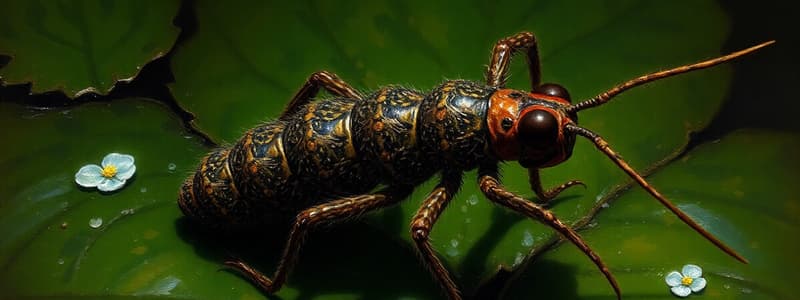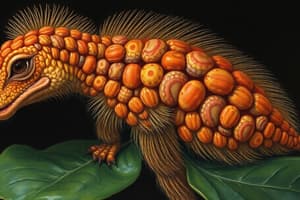Podcast
Questions and Answers
Which of the following characteristics is NOT a defining feature of animals?
Which of the following characteristics is NOT a defining feature of animals?
- Autotrophic nutrition (correct)
- Multicellular eukaryote
- Heterotrophic nutrition
- Presence of nerves and muscles
What evidence suggests that the common ancestor of all animals was a colonial flagellated protist?
What evidence suggests that the common ancestor of all animals was a colonial flagellated protist?
- The presence of flagella in all animal cells
- Fossil records of early animal groups exhibiting flagella
- Similarities in the morphology and molecular structure of modern colonial flagellated protists and animals (correct)
- The ability of some animals to reproduce asexually using flagellated cells
What is the primary function of anchoring junctions in animal tissues?
What is the primary function of anchoring junctions in animal tissues?
- To provide structural support and connect cells together (correct)
- To control the movement of substances across cell membranes
- To allow for cell-to-cell communication
- To prevent the passage of substances between cells
Which type of cell junction is responsible for preventing the leakage of substances between cells?
Which type of cell junction is responsible for preventing the leakage of substances between cells?
How do animal cells maintain tissue stability in the absence of a cell wall?
How do animal cells maintain tissue stability in the absence of a cell wall?
Why is the diversity of animal species so vast?
Why is the diversity of animal species so vast?
Which of the following is NOT a factor that contributes to the diversity of animal species?
Which of the following is NOT a factor that contributes to the diversity of animal species?
Which statement best describes the difference in cell structure between animal and plant cells?
Which statement best describes the difference in cell structure between animal and plant cells?
Which of the following best describes the difference between spiral cleavage and radial cleavage?
Which of the following best describes the difference between spiral cleavage and radial cleavage?
Which of the following is NOT a defining characteristic of a triploblastic animal?
Which of the following is NOT a defining characteristic of a triploblastic animal?
What is the primary difference between a protostome and a deuterostome?
What is the primary difference between a protostome and a deuterostome?
What is the significance of the vegetal pole in the development of an animal embryo?
What is the significance of the vegetal pole in the development of an animal embryo?
During gastrulation, which germ layer is formed LAST?
During gastrulation, which germ layer is formed LAST?
What is the function of a blastocoel?
What is the function of a blastocoel?
Which of the following statements is TRUE regarding the process of cleavage?
Which of the following statements is TRUE regarding the process of cleavage?
What is the main advantage of sexual reproduction in animals?
What is the main advantage of sexual reproduction in animals?
What is the primary function of homeostasis?
What is the primary function of homeostasis?
Which of the following is NOT a method of homeostatic regulation?
Which of the following is NOT a method of homeostatic regulation?
Which of these feedback mechanisms helps return a variable to its set point?
Which of these feedback mechanisms helps return a variable to its set point?
Which of these is an example of a positive feedback loop?
Which of these is an example of a positive feedback loop?
What is the primary difference between endotherms and ectotherms?
What is the primary difference between endotherms and ectotherms?
Which of the following is an example of a homeostatic mechanism used by endotherms to maintain body temperature?
Which of the following is an example of a homeostatic mechanism used by endotherms to maintain body temperature?
Which of these best describes a homeotherm?
Which of these best describes a homeotherm?
Which of these is an example of a heterotherm?
Which of these is an example of a heterotherm?
Which of the following is NOT a type of connective tissue?
Which of the following is NOT a type of connective tissue?
Which of the following tissue types is responsible for the secretion of mucus and its movement?
Which of the following tissue types is responsible for the secretion of mucus and its movement?
What is the function of stratified squamous epithelial tissue?
What is the function of stratified squamous epithelial tissue?
Which of the following is NOT a function of connective tissue?
Which of the following is NOT a function of connective tissue?
What is the function of simple squamous epithelial tissue?
What is the function of simple squamous epithelial tissue?
Which of the following is an example of an organ system?
Which of the following is an example of an organ system?
What is the main difference between afferent and efferent neurons?
What is the main difference between afferent and efferent neurons?
Which of the following best describes the function of myelin?
Which of the following best describes the function of myelin?
What is the primary function of the hypothalamus in thermoregulation?
What is the primary function of the hypothalamus in thermoregulation?
Which of the following is NOT a contributing factor to thermal acclimatization?
Which of the following is NOT a contributing factor to thermal acclimatization?
How does vasoconstriction contribute to thermoregulation?
How does vasoconstriction contribute to thermoregulation?
What is the primary difference between ectotherms and endotherms in terms of thermoregulation?
What is the primary difference between ectotherms and endotherms in terms of thermoregulation?
How does torpor differ from normal thermoregulation?
How does torpor differ from normal thermoregulation?
Which of the following is NOT a mechanism by which the skin regulates heat transfer?
Which of the following is NOT a mechanism by which the skin regulates heat transfer?
Which of these best describes the relationship between organismal performance and thermoregulation?
Which of these best describes the relationship between organismal performance and thermoregulation?
In the thermoregulation process, what is the role of the autonomic nervous system?
In the thermoregulation process, what is the role of the autonomic nervous system?
Which type of tissue is responsible for providing support, flexibility, and joint movement?
Which type of tissue is responsible for providing support, flexibility, and joint movement?
What is the primary function of the nervous system?
What is the primary function of the nervous system?
Which type of muscle tissue is found in the heart?
Which type of muscle tissue is found in the heart?
Which of the following is NOT a characteristic of neurons?
Which of the following is NOT a characteristic of neurons?
What is the function of glial cells?
What is the function of glial cells?
Which of the following statements correctly describes the difference between exocrine and endocrine glands?
Which of the following statements correctly describes the difference between exocrine and endocrine glands?
Which type of neuron transmits signals from sensory receptors to the central nervous system?
Which type of neuron transmits signals from sensory receptors to the central nervous system?
Which of the following is an example of an effector in a basic neuron circuit?
Which of the following is an example of an effector in a basic neuron circuit?
Flashcards
Animal
Animal
A non-human multicellular eukaryote lacking a cell wall.
Animal Characteristics
Animal Characteristics
Traits include no cell wall, motility, and heterotrophic feeding.
Animal Origins
Animal Origins
All animals descend from a common colonial flagellated protist.
Diversity of Animals
Diversity of Animals
Signup and view all the flashcards
Tissue Stability in Animals
Tissue Stability in Animals
Signup and view all the flashcards
Anchoring Junction
Anchoring Junction
Signup and view all the flashcards
Tight Junction
Tight Junction
Signup and view all the flashcards
Gap Junction
Gap Junction
Signup and view all the flashcards
Homeostasis
Homeostasis
Signup and view all the flashcards
Negative Feedback Loop
Negative Feedback Loop
Signup and view all the flashcards
Positive Feedback Loop
Positive Feedback Loop
Signup and view all the flashcards
Feedforward
Feedforward
Signup and view all the flashcards
Endotherm
Endotherm
Signup and view all the flashcards
Ectotherm
Ectotherm
Signup and view all the flashcards
Homeotherm
Homeotherm
Signup and view all the flashcards
Heterotherm
Heterotherm
Signup and view all the flashcards
Protostomes
Protostomes
Signup and view all the flashcards
Deuterostomes
Deuterostomes
Signup and view all the flashcards
Spiral cleavage
Spiral cleavage
Signup and view all the flashcards
Radial cleavage
Radial cleavage
Signup and view all the flashcards
Gastrulation
Gastrulation
Signup and view all the flashcards
Bilateral symmetry
Bilateral symmetry
Signup and view all the flashcards
Cells
Cells
Signup and view all the flashcards
Tissues
Tissues
Signup and view all the flashcards
Organs
Organs
Signup and view all the flashcards
Organ Systems
Organ Systems
Signup and view all the flashcards
Epithelial Tissue
Epithelial Tissue
Signup and view all the flashcards
Connective Tissue
Connective Tissue
Signup and view all the flashcards
Muscle Tissue
Muscle Tissue
Signup and view all the flashcards
Nervous Tissue
Nervous Tissue
Signup and view all the flashcards
Thermoregulation
Thermoregulation
Signup and view all the flashcards
Hypothalamus
Hypothalamus
Signup and view all the flashcards
Thermal Acclimatization
Thermal Acclimatization
Signup and view all the flashcards
Vasoconstriction
Vasoconstriction
Signup and view all the flashcards
Vasodilation
Vasodilation
Signup and view all the flashcards
Torpor
Torpor
Signup and view all the flashcards
Cartilage
Cartilage
Signup and view all the flashcards
Adipose tissue
Adipose tissue
Signup and view all the flashcards
Fibrous Connective Tissue
Fibrous Connective Tissue
Signup and view all the flashcards
Neuron Types
Neuron Types
Signup and view all the flashcards
Skeletal Muscle
Skeletal Muscle
Signup and view all the flashcards
Cardiac Muscle
Cardiac Muscle
Signup and view all the flashcards
Exocrine Glands
Exocrine Glands
Signup and view all the flashcards
Functions of Nervous System
Functions of Nervous System
Signup and view all the flashcards
Study Notes
General Concepts
- Animal Definition: Animal = non-human animal. All members of the animal kingdom.
- Animal Characteristics: Multicellular eukaryotes (lack cell walls), heterotrophs, motile, sexual or asexual reproduction, have nerves and muscles.
- Animal Diversity: Diverse species, diverse habitats, diverse characteristics.
- Animal Origins: Common ancestor for all animals is a colonial flagellated protist in Precambrian. Similarity to modern colonial flagellated species and morphological/molecular evidence support this.
- Animal Classification: (not detailed in the provided text)
Animal Characteristics
- Multicellular Eukaryotes: Animals are made of many cells and their cells have a nucleus.
- Heterotrophs: Animals get their energy by consuming other organisms.
- Motile: Animals can move around.
- Sexual or Asexual Reproduction: Animals can reproduce sexually or asexually.
- Nerves and Muscles: Animals have nerves and muscles to help with movement and response to stimuli.
Animal Diversity
- Diverse Species: Animals come in many different species.
- Diverse Habitats: Animals live in many different habitats.
- Diverse Characteristics: Animals have many different characteristics distinguishing them from each other.
Animal Origins
- Common Ancestor: All animals share a common ancestor.
- Precambrian: The ancestor existed in the Precambrian period.
- Evidence: Evidence for this comes from similarities to modern colonial flagellated species and morphological/molecular evidence.
Tissue Stability in Animals
- Plant vs. Animal Cells: Animal cells do not have a cell wall, unlike plant cells which give them rigidity.
- Achieving Stability: Animal tissues gain stability through extracellular junctions which maintain cell shape, structure and function.
- Types of Junctions:
- Anchoring Junctions: Connect proteins to join cells together.
- Tight Junctions: Prevent passing things through cells, holding cells close together.
- Gap Junctions: Enable cell-cell communication and ion exchange between cells.
Animal Body Plans
- Embryonic development pattern: Influences animal body plans
- Germ cell layers: Influences animal body plans
- Body symmetry: Influences animal body plans
- Body cavity type: Influences animal body plans
Sexual Reproduction
- Process: Germ line cells undergo meiosis to produce haploid gametes; gametes fuse (fertilization) to form a diploid zygote.
Asexual Reproduction
- Examples: Budding in hydra, fragmentation in echinoderms, parthenogenesis in insects.
- Protostomes: Spiral cleavage; each cell's developmental path fixed as it's produced; each blastomere cannot become a complete organism by itself.
- Deuterostomes: Radial cleavage; each cell can become a complete organism; developmental path not predetermined.
Germ Layers
- Diploblastic: Two germ layers (ectoderm, endoderm).
- Triploblastic: Three germ layers (ectoderm, endoderm, mesoderm).
- Mesoderm: Forms muscles, skeleton, and structures between gut and external covering.
- Ectoderm: Forms external covering (skin) and nervous system.
- Endoderm: Forms gut lining and digestive tract,
Embryonic Development Differences
- Protostomes: Spiral cleavage.
- Deuterostomes: Radial cleavage.
- Coelom: A body cavity separating the gut from body wall. Fluids fill body cavities.
- Acoelomate: No body cavity.
- Pseudocoelomate: Fluid-filled space between endoderm and mesoderm.
Homeostasis
- Definition: Maintaining the body's internal environment near a stable level.
- Methods: Negative feedback loops, positive feedback loops, feedforward.
- Negative feedback: Counteracts deviations from the set point.
- Positive feedback: Amplifies deviations from the set point.
- Feedforward: Anticipating future needs to adjust physiology in advance.
Thermoregulation
- Endotherms: Obtain heat primarily from internal reactions.
- Ectotherms: Obtain heat primarily from external environment.
- Homeotherms: Maintain constant body temperature.
- Heterotherms: Body temperature varies between self-regulating and being influenced by environment.
- Behavioral Responses: Some animals can regulate temperature through behavioral changes.
Key Terms (From pages 8-14)
- Organ Systems: Groups of organs working together
- Tissue Types: Epithelial, connective, muscle, nerve
- Neuron Types: Afferent, efferent, interneurons
- Glial Cells: Support and insulate neurons (e.g., astrocytes, Schwann cells).
- Hypothalamus: Body's 'thermostat'.
- Temperature regulation: Maintaining body temp at optimal levels.
- Torpor: Decrease in body temp for conservation of energy.
- Acclimatization: Changes in the body related to temperature tolerance.
Animal Body Organization & Nervous System
- Layers of Organization: Cells, tissues, organs, organ systems.
- Tissue Types: Epithelial, connective, muscle, nervous
- Neuron Structure: Dendrites, axons.
Tissue Types (from page 11)
- Epithelial Tissue: Sheetlike layers covering body surface and internal organs.
- Connective Tissue: Consists of cell networks, supports other tissues, and transmits mechanical forces.
Connective Tissue
- Types: Loose connective tissue (supports, elasticity, diffusion), cartilage (support, flexibility, movement), adipose tissue (energy reserves, insulation), fibrous connective tissue (strength), bone (movement, support); blood (substance transport)
Studying That Suits You
Use AI to generate personalized quizzes and flashcards to suit your learning preferences.




